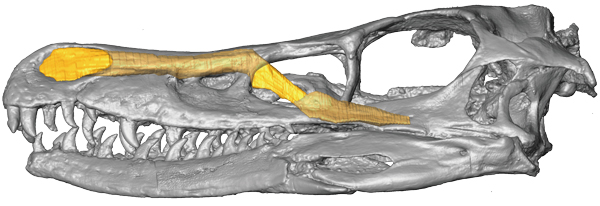Disclaimer: machine translated by DeepL which may contain errors.
Seinoro Tada (Department of Earth and Planetary Science, 3rd year doctoral student )
Takanobu Tsubichi (Adjunct Associate Professor, Department of Earth and Planetary Science / Principal Investigator, National Museum of Nature and Science )
Were dinosaurs exothermal or endothermal?
As a clue to this question, the structure of the respiratory nasal cavity, which only endothermic animals possess in their noses, has been the focus of attention, but its function and relationship to endothermy have not been clear.
In this study, we found that the physiological function of the enlarged nasal cavity with nasal cilia may be mainly cooling of the developing brain.
Furthermore, the nasal cavity of theropod dinosaurs was not as large as that of their avian descendants, and this function appears to have been less well developed.
Thus, by focusing on the nose and brain, we can discuss the physiological functions and changes in the skull that occurred during the evolution from dinosaurs to birds from a new angle.
![]()
The difference between endothermic (warm-blooded) organisms, which maintain a high body temperature through metabolism, and ectothermic (cold-blooded) organisms, which change their body temperature according to the external temperature, causes significant differences in their ecology and behavior. The question, "What metabolic patterns did dinosaurs have? As a clue to this question, a complex spiral-shaped structure called the respiratory nasal cork in the noses of the present-day endotherms, mammals and birds, has been focused on, but the specific function of this structure has not been clarified.
In this study, we examined the roles of the nasal corymbs and nasal cavity by observing the noses of various terrestrial vertebrates. First, the relative size of the nasal cavity to the skull was significantly larger in endothermic animals than in exothermic animals. On the other hand, there was no significant difference in the relative size of the nasal cavity to the whole body between endothermic and ectothermic animals. These results suggest that the large nasal cavity serves a physiological function related to structures within the head, rather than the whole body as previously assumed.
The nasal cavity contains many blood vessels, and it has been shown that warm blood from the trunk is cooled by the air in the nasal cavity and travels to the brain, thereby protecting the brain from a sudden rise in temperature and providing a cooling mechanism. In this study, we proposed the hypothesis that the nasal cavity and nasal concha are not involved in the metabolic regulation of the entire body as previously thought, but function primarily as efficient cooling devices for the large brain, which is a characteristic feature of endothermic animals.
In addition, we examined the development of the nasal function in pre-bird dinosaurs with the physiological role of brain cooling in mind. In this Research Student, the nasal cavity was digitally reconstructed in 3D from CT data of a fossil specimen of Velociraptor mongoliensis, a theropod dinosaur relatively close to birds, and compared with those of extant animals. The results suggest that the relative size of the nasal cavity of Velociraptor mongoliensis was smaller than that of endothermic birds, and that the function of heat exchange in the nasal cavity was not so well developed.
When did the cooling function of the brain develop during the evolution from theropod dinosaurs to birds? In this study, we further inferred the evolutionary process based on the shape of the facial bones surrounding the nasal cavity. The theropod dinosaur's nasal cavity was covered on the underside by a bone called the maxilla, which had an elongated, tubular shape overall. This seems to have occurred around the time of the appearance of the Confucius bird ( Confuciusornis sanctus ). This means that the development of the nasal cavity and its physiological functions occurred after the appearance of the Archaeopteryx lithographica, the famous "earliest bird" in the evolution from dinosaurs to birds. 150 million years ago, the ancestral bird did not have all the characteristics of living birds. The results of this research are consistent with the findings of S. Tada et al.
The results of this study were published in S. Tada et al., Royal Society Open Science, 10, 4 (2023).
(From a web article on April 12, 2023)
Frontiers of Science for Undergraduates



